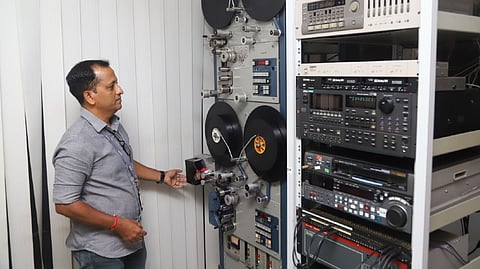

CHENNAI: On a sultry afternoon in Chennai, we find ourselves ensconced in the haloed campus of Prasad Film Labs, Prasad Corp in Saligramam. The massive digital workspace that we enter is shrouded in darkness, pitch black so to speak, save for the illumination of the workstations on which hundreds of film technicians pore over reams of cinematic footage. They are archaeologists, artistes and engineers rolled into one, as they check the digitised video for visible signs of damage — scratches, cigarette burns, fades, flickering, warping, dirt, grain and more. It’s a painstaking affair that needs to be carried out frame by singular frame, in the hopes of preserving such important vestiges of culture, such as classic cinema from India, and around the world, for decades to come.
The folks at Prasad Corp know a thing or two about film restoration, considering they have digitised and restored as many as 600 films, essentially endowing these features with an ‘as good as new’ tag. The company’s 600th restored classic was the Malayalam film Thamp (1978) that premiered at the Cannes Film Festival last month. The company has an enviable track record in film restorations with a repertoire that could light up the eyes of any true cinephile. Titles such as Lawrence of Arabia (1962), How the West Was Won (1962), A Fistful of Dollars (1964), and Gandhi (1982) have been brought back to life on these shores. Most recently, Prasad Corp was involved in a state of the art 8K restoration of West Side Story (1961) My Fair Lady (1964).
It seems fair to presume that a 16-year-long journey in film digitisation, restoration and preservation carried out by arguably one of the largest restoration teams globally (with over 400 staffers) might be a highly-thought through business model that was conceived with an eye on the future. It’s essentially a mission that has been passed down successfully from the patriarch LV Prasad, to three generations of the Prasad family.
Of course, Sai Prasad, the Director of Prasad Corp looks at this from a different perspective. He tells us, “I wouldn’t call it a corporate decision brought about by design or strategy. For starters, we happened to be the custodians of so many films in our vault. And we were appalled that hundreds of features, stored either as negatives or theatrical prints, ran the risk of being ruined, in the absence of preservation mechanisms. As the world of cinema moved towards digital technology, we realised that we were in a position to leverage our expertise and create a bridge of sorts — between the traditional universe of celluloid and the modern ecosystem of digital cinema.” What they ended up doing is creating a time machine that allowed filmmakers and producers to bring their yesteryear creations back to life.
It goes without saying that a sense of deja vu reigns supreme in the restoration works lined up by the company. Close to a decade ago, the legendary American filmmaker Martin Scorsese's The Film Foundation and Warner Brothers had commissioned Prasad EFX to restore the classic 1948 film The Red Shoes. For its 600th restoration project, Prasad Corp once again joined forces with The Film Foundation and Shivendra Singh Dungarpur's Film Heritage Foundation to restore G Aravindan’s Thamp to life. The restoration process, as far as the team was concerned, was nothing short of a miracle. As per the company, the only available film elements of Thamp were a dupe negative made from a print, and a heavily used theatrical copy that was obtained from the NFAI, Pune – both of which were not in a good condition.
The grading of the film was supervised by the cinematographer of the film Shaji Karun as well as G. Aravindan’s son Ramu Aravindan. This was carried out at L’Immagine Ritrovata, a highly specialised film restoration laboratory in Bologna, Italy. The facility is known for working on the restoration of hundreds of high-profile world cinema titles such as Satyajit Ray’s Apu Trilogy and his other classics as well as masterpieces by Bergman, Fellini, Ghatak, Godard, and Truffaut. Most of these films are now part of the American distribution and streaming company The Criterion Collection.
When asked if Prasad Corp would be eyeing the distribution ecosystem anytime soon, Sai Prasad, who considers himself a celluloid purist, tells us, “It’s a fiercely competitive space and I don’t see us making a mark in that arena. However, you’d be happy to know that we have embarked on a digitisation project involving Mani Ratnam’s incomparable oeuvre.” It’s a project that the team is really excited about, especially considering that the auteur himself has given the team a two thumbs up.
Are you in Chennai? Then click here to get our newspaper at your doorstep!
Visit news.dtnext.in to explore our interactive epaper!
Download the DT Next app for more exciting features!
Click here for iOS
Click here for Android